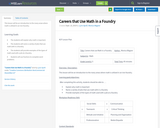
This lesson will be an introduction to the many areas where math is utilized in an iron foundry.
- Subject:
- Mathematics
- Material Type:
- Lesson
- Date Added:
- 09/03/2019

This lesson will be an introduction to the many areas where math is utilized in an iron foundry.
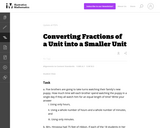
This task gives students word problems with a given a set of a specified size and a specified number of subsets. The questions ask the student to find out the size of each of the subsets.

An application of fractions with ties to culinary careers and life skills in the upper elementary grades.

In Module 3, students' understanding of addition and subtraction of fractions extends from earlier work with fraction equivalence and decimals. This module marks a significant shift away from the elementary grades' centrality of base ten units to the study and use of the full set of fractional units from Grade 5 forward, especially as applied to algebra.
Find the rest of the EngageNY Mathematics resources at https://archive.org/details/engageny-mathematics.

Grade 5s Module 4 extends student understanding of fraction operations to multiplication and division of both fractions and decimal fractions. Work proceeds from interpretation of line plots which include fractional measurements to interpreting fractions as division and reasoning about finding fractions of sets through fraction by whole number multiplication. The module proceeds to fraction by fraction multiplication in both fraction and decimal forms. An understanding of multiplication as scaling and multiplication by n/n as multiplication by 1 allows students to reason about products and convert fractions to decimals and vice versa. Students are introduced to the work of division with fractions and decimal fractions. Division cases are limited to division of whole numbers by unit fractions and unit fractions by whole numbers. Decimal fraction divisors are introduced and equivalent fraction and place value thinking allow student to reason about the size of quotients, calculate quotients and sensibly place decimals in quotients. Throughout the module students are asked to reason about these important concepts by interpreting numerical expressions which include fraction and decimal operations and by persevering in solving real-world, multistep problems which include all fraction operations supported by the use of tape diagrams.
Find the rest of the EngageNY Mathematics resources at https://archive.org/details/engageny-mathematics.
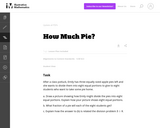
The purpose of this task is to help students see the connection between aÖb and ab in a particular concrete example. The relationship between the division problem 3Ö8 and the fraction 3/8 is actually very subtle.

(Nota: Esta es una traducción de un recurso educativo abierto creado por el Departamento de Educación del Estado de Nueva York (NYSED) como parte del proyecto "EngageNY" en 2013. Aunque el recurso real fue traducido por personas, la siguiente descripción se tradujo del inglés original usando Google Translate para ayudar a los usuarios potenciales a decidir si se adapta a sus necesidades y puede contener errores gramaticales o lingüísticos. La descripción original en inglés también se proporciona a continuación.)
En el módulo 3, la comprensión de los estudiantes de la adición y la resta de las fracciones se extiende desde el trabajo anterior con equivalencia de fracción y decimales. Este módulo marca un cambio significativo lejos de la centralidad de los grados elementales de las diez unidades de base al estudio y el uso del conjunto completo de unidades fraccionarias desde el avance de grado 5, especialmente como se aplica al álgebra.
Encuentre el resto de los recursos matemáticos de Engageny en https://archive.org/details/engageny-mathematics.
English Description:
In Module 3, students' understanding of addition and subtraction of fractions extends from earlier work with fraction equivalence and decimals. This module marks a significant shift away from the elementary grades' centrality of base ten units to the study and use of the full set of fractional units from Grade 5 forward, especially as applied to algebra.
Find the rest of the EngageNY Mathematics resources at https://archive.org/details/engageny-mathematics.

(Nota: Esta es una traducción de un recurso educativo abierto creado por el Departamento de Educación del Estado de Nueva York (NYSED) como parte del proyecto "EngageNY" en 2013. Aunque el recurso real fue traducido por personas, la siguiente descripción se tradujo del inglés original usando Google Translate para ayudar a los usuarios potenciales a decidir si se adapta a sus necesidades y puede contener errores gramaticales o lingüísticos. La descripción original en inglés también se proporciona a continuación.)
Módulo 4 de grado 5 extiende la comprensión del estudiante de las operaciones de fracción a la multiplicación y la división de fracciones y fracciones decimales. El trabajo procede de la interpretación de los gráficos de línea que incluyen mediciones fraccionales para interpretar las fracciones como división y razonamiento sobre la búsqueda de fracciones de conjuntos a través de la fracción por multiplicación de números enteros. El módulo procede a la fracción por multiplicación de fracción en formas de fracción y decimal. Una comprensión de la multiplicación como escala y multiplicación por N/N como multiplicación por 1 permite a los estudiantes razonar sobre productos y convertir fracciones en decimales y viceversa. Los estudiantes son presentados al trabajo de división con fracciones y fracciones decimales. Los casos de división se limitan a la división de números enteros por fracciones unitarias y fracciones unitarias por números enteros. Se introducen divisores de fracción decimal y la fracción equivalente y el pensamiento del valor del lugar permiten al alumno razonar sobre el tamaño de los cocientes, calcular los cocientes y colocar decimales con sensatez en los cocientes. A lo largo del módulo, se les pide a los estudiantes que razonen sobre estos conceptos importantes interpretando expresiones numéricas que incluyen operaciones de fracción y decimales y perseverar en la resolución de problemas de varios pasos en el mundo real que incluyen todas las operaciones de fracción compatibles con el uso de diagramas de cintas.
Encuentre el resto de los recursos matemáticos de Engageny en https://archive.org/details/engageny-mathematics.
English Description:
Grade 5s Module 4 extends student understanding of fraction operations to multiplication and division of both fractions and decimal fractions. Work proceeds from interpretation of line plots which include fractional measurements to interpreting fractions as division and reasoning about finding fractions of sets through fraction by whole number multiplication. The module proceeds to fraction by fraction multiplication in both fraction and decimal forms. An understanding of multiplication as scaling and multiplication by n/n as multiplication by 1 allows students to reason about products and convert fractions to decimals and vice versa. Students are introduced to the work of division with fractions and decimal fractions. Division cases are limited to division of whole numbers by unit fractions and unit fractions by whole numbers. Decimal fraction divisors are introduced and equivalent fraction and place value thinking allow student to reason about the size of quotients, calculate quotients and sensibly place decimals in quotients. Throughout the module students are asked to reason about these important concepts by interpreting numerical expressions which include fraction and decimal operations and by persevering in solving real-world, multistep problems which include all fraction operations supported by the use of tape diagrams.
Find the rest of the EngageNY Mathematics resources at https://archive.org/details/engageny-mathematics.
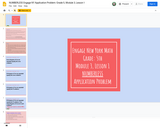
*This numberless application problem is the same application problem used the engage lesson: Grade 5, Module 3, Lesson 1
*Numberless word problems are used to support students in solving word problems. They allow students to discover for themselves the structure of the problems they're solving. In doing so, they will be able to successfully find the operation or operations they need to use to determine the solution.
*Numberless word problems help students develop number sense, make sense of word problems, and encourage precise mathematical vocabulary.
*Based on the work of Brian Bushart.
*Created using ideas from WI Math Institute training. Google Slides presentation created as an adaption of WiseLearn resource by Sarah Martinsen and Kelly Shaefer.
*These slides could be inserted into the free Engage New York lesson google slides from embarc.online.
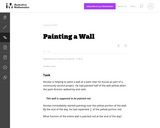
The purpose of this task is for students to find the answer to a question in context that can be represented by fraction multiplication. This task is appropriate for either instruction or assessment depending on how it is used and where students are in their understanding of fraction multiplication.
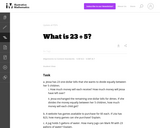
When a division problem involving whole numbers does not result in a whole number quotient, it is important for students to be able to decide whether the context requires the result to be reported as a whole number with remainder or a mixed number.